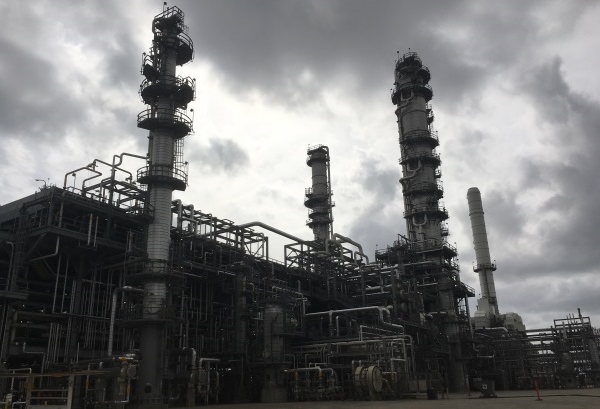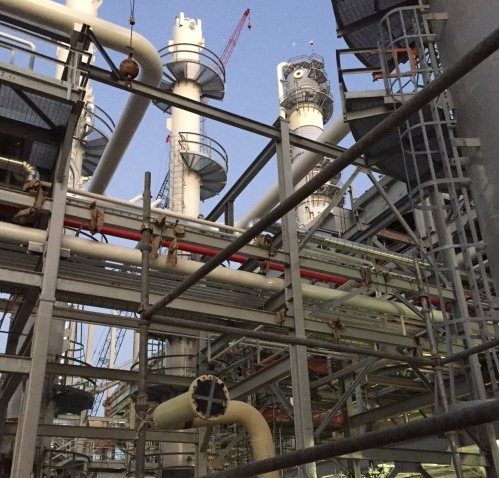As the oil market continues to change abroad and in the United States, so, too, do the refineries themselves. And keeping sites and workers safe has become a top priority. That’s what brought a PK Industrial crew to Valero Houston Refinery between June 2015 and November 2016.
On the ~250-acre (1 km²) site, Valero was installing a new crude topper, which was designed to take the crude oil from Eagle Ford and separate it into different parts. The plan for PK Industrial was to install a coating system to the steel structure using intumescent coatings, working both in the shop and in the field.
On this new construction project, Valero decided to protect the crude topper right from the start, which meant that installing intumescent coatings was taking them a step above and beyond the norm, and PK Industrial was the company to take them there.
Coordination, Location, Realization
Since this was a new build, PK Industrial was able to coordinate the project from scratch, which started before the structural steel landed on the jobsite in Houston. The overall project included bringing the steel through PK Industrial’s Houston and Augusta, Georgia sites, moving the pieces to a modular yard in Port Allen, Louisiana, and finally assembling everything at the refinery. On top of that, the steel came from various fabricators throughout the states.
One of the ways that PK Industrial used to help keep things in order was its proprietary tracking system. “Valero could check and see at any point in time where an individual piece of steel was in real time, so that helped out a lot,” explained Landon Riggs, PK Industrial’s vice president of operations.
Organizing the steel pieces through PK Industrial’s headquarters and sending them through the modular yard started in September 2014. There would be a total of 150,000 square feet (13,935.5 m²) of structural steel coated with a full system that included intumescent fireproofing. Before the steel could get to the jobsite in Houston, as much was done in the shop as possible before being shipped via barge from Louisiana.
To start, 40- and 30-person crews at PK Industrial’s shops worked to blast the steel to achieve NACE No. 2/Society for Protective Coatings (SSPC) Surface Preparation (SP) 10: Near-White Blast Cleaning. “The process is basically a surface prep garnet blast, and there’s an epoxy hold primer,” Riggs explained. To accomplish that, they used abrasive pots from Schmidt, media from GMA, and a layer of Intergard 251. (All coatings came from International Paint.) All spent abrasive was collected and disposed of properly at the shops, and then the primer was spray applied to achieve a thickness of 2‒3 mils (50.8‒76.2 microns). The primer was laid down using Graco airless pumps and Binks conventional spray rigs.
According to Riggs, “Ninety percent of the steel was fireproofed at the shop locations before being shipped to the module yard.” Any areas identified as connections were protected. “These connections are protected so the field can erect the steel as fast as possible. You want to fireproof as much in the shop as you can without causing any clearance issues on the connections. This allows the erectors to bolt the steel together quickly, and it allows for less time in the field for fireproofing completion,” he explained.
Any areas that weren’t blocked out received the intumescent fireproofing layer in the shops. That material was Chartek 1709 Intumescent Fireproofing, and it was applied at an average of 10.7 mm (0.4 inches). According to literature online, Chartek 1709 provides fire protection up to four hours per Underwriters Laboratories (UL) 1709: Rapid Rise Fire Test of Protection Materials for Structural Steel.
Once the fireproofing was installed, the crew tested the thicknesses using fixed probe electromagnetic mil gages from DeFelsko and Elcometer. Any areas that weren’t coated with the intumescent received a 4- to 6-mil (101.6‒152.4 microns) intermediate coat called Intergard 345.

With that, the steel was shipped to the modular yard to be assembled, and then all modules were shipped and placed on steel supports at the jobsite. There, a crew of 10 to 40 people got to work, depending on the task. The onsite crew finished up the fireproofing of the connection areas first. “If you fireproof in the shop, you wouldn’t be able to put the steel up. That’s why you have connections that go in the field,” Riggs explained. The last step was to apply the Interthane 990HS topcoat at 2‒3 mils (50.8‒76.2 microns) to everything except the connections.
Keeping Safe
Once on the construction site, the crew members wore typical personal protective equipment (PPE), such as ear plugs, H2S monitors, hard hats, and fire-retardant clothing, and they used 100 percent tie-off double-hook lanyards while working on the lifts and scaffolding. The crew worked on lifts about 75 percent of the time; the other 25 percent of the work was completed on scaffolds supplied by the client.
“We do all of our own in-house training for aerial lifts and scaffolding,” Riggs said. They also had a full-time safety rep on site. But the training and the reps couldn’t accommodate one aspect that challenged this crew’s safety: the weather.
“It was an unbelievably hot summer, and heat issues were a significant concern,” Riggs said. Summer in Texas can be hot! “So we came up with different cooling stations, different ways to keep the guys hydrated throughout the days.” One of those ways was to have them wear Frogg Toggs’ wrist bands and head/neck bands. “They were life savers for us,” he continued. “Some parts of the units were operational, so it was extremely hot where they were working.”
The crew also relied on monitoring. “Safety is our number one concern that we watch for, and the heat was definitely one of the most important areas for us to control,” Riggs said. They shifted their work times for when it was cooler outside, and they increased their water breaks, using hydrating logs to keep track. “Heat exhaustion can happen quickly to somebody without the person knowing it, so we had to monitor all our team members throughout the day and take the proper precautions,” he continued.

“Our employees are our number one asset, and their ability to go home to their families is our number one concern,” Riggs succinctly explained.
Successful Work
Although PK Industrial has continued to work applying intumescent coatings in other plants, they’ve only done some other small work at this Valero plant. That’s not for lack of success with this project, though.
“The client was very satisfied,” Riggs said. “We received a reference letter from the construction manager for the work we did on this project. And PK has secured additional work through the client, and the successful work completed on this project helped tremendously.”
This feature is part of a special anniversary series in 2017 in which CoatingsPro reflects on and updates the magazine’s most-read digital stories. This is a new project completed by a company that was featured online. To see the original article from May 2014, please click here.